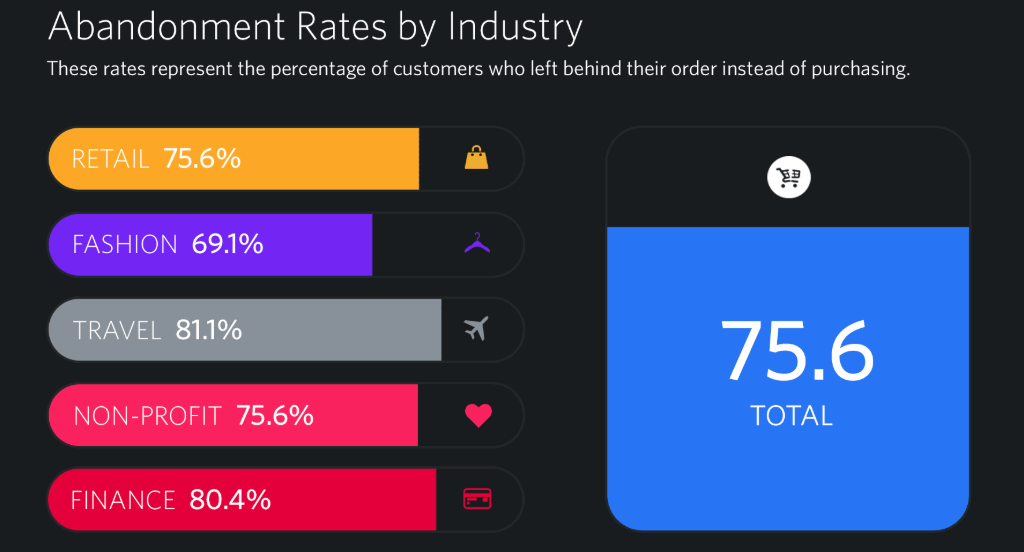
10 Ways to Drive More Ecommerce Conversions From Wish Lists
Most ecommerce brands have a high cart abandonment rate, but few know how to reduce it. Learn how a wish list can provide a great customer experience that boosts conversions.
Why should an ecommerce website manager care about wish lists and related conversions?
Consider this:
A SaleCycle study (see the graphic below) put the average ecommerce cart abandonment rate during Q1 2018 at 75.6 percent.

That means that more than three of every four shoppers who added items to an online shopping cart decided not to complete the purchase.
Is that your experience as an ecommerce retailer, too?
If so, wouldn’t it be helpful to find a way to reduce the drop-off rate and convert more of your ecommerce website visitors into paying customers?
One of the most effective means we’ve found to short-circuit cart abandonment and encourage the eventual purchase is to provide a “wish list” function for shoppers.
The technology isn’t overly complicated, but there are some pointers you’ll want to consider for the best results.
In this article we’ll cover the basics of the ecommerce wish list and how you can optimize your wish-list conversion rate.
So, What Is a Wish List?
The wish list feature allows ecommerce customers to create a list of items they aren’t ready to purchase yet, but hope to either buy for themselves or receive as a gift in the future. They provide an easy way for shoppers to organize the products they want, making it unnecessary to use the shopping basket for quick recall.
Not only do properly designed wish lists lower the cart abandonment rate (because shoppers won’t need to add to their cart until they’re ready to check out), they help improve the customer experience on your site by making it easier for people to buy from you and encourage others to do the same.
What’s the Difference Between a “Wish List” and a “Save for Later” Button?
Here’s the short answer: Not much.
Most ecommerce website designers will tell you there are two primary differences between ecommerce “Save for Later” functions and ecommerce wish lists:
- Visitors must create an account and be signed in before they can add items to the list, but no account is necessary to save for later.
- Save-for-later items are visible from the shopping cart, but wish lists aren’t.
- Save-for-later items may include quantities desired, but wish lists can’t.
While these points may or may not be valid, the only real difference between the two is the terminology.
There’s no reason why you can’t use the wish list and save-for-later feature in the exact same way: to provide a way for shoppers to hold off on adding products to the cart before they are ready to buy, and then give then a super-simple way to pull those items up quickly and place the order.
Enjoying this article?
Subscribe to our newsletter, Good Question, to get insights like this sent straight to your inbox every week.
Our 10 Top Pointers for Getting the Most from Your Ecommerce Wish List
Wish lists allow shoppers to compile an easily accessible list of potential purchases. Just as your clothes dryer isn’t the best place to store your clothes, the shopping cart isn’t the ideal spot for holding items customers want but aren’t yet ready to buy.
The wish list, however, is a great spot for quick storage, reminders, and retrieval.
Here are our 10 top pointers for getting the most from this ecommerce feature:
- Use a wish list or use a save-for-later feature, but don’t use both. As we said earlier, the difference between the two is slim. You’ll confuse your visitors if you provide both. Which should you choose? Consider your audience. Test both features. Use the one that gets the best results.
- Take advantage of the information gained to inform your email marketing strategy. Is an item going on sale? Notify the people who’ve added that product to their list. Holiday special coming up? Remind your prospects about the items on their wish lists. This could be the perfect time to buy.
- Make creating the list super simple. Customers who are logged in shouldn’t have to take any extra steps (other than to segment their lists in the way that best suits them). Non-registered guests can provide an email address to get started and provide additional information later.
- Blend the wish list into your overall site design to serve as an ongoing reminder of the items the shopper wants to buy. Moving items to the shopping cart shouldn’t take more than a click.
- Test using the information on the wish list for remarketing. Compare results based on variables like time elapsed since the item was saved and proximity to the purchase of other items.
- Track contents for audience-specific information on product trends. You’ll not only learn more about the demand for those items, but you can use the information to come up with cross-sell, up-sell, and down-sell ideas.
- Leverage wish lists to learn more about your customers and prospective customers. Do they need more information before buying? Are they hoping the item will go on sale? What’s stopping them from purchasing the item(s) now?
- Don’t use the wish list as a bandage for weak product information pages. Correctly configured, the product page is an essential part of your path to sales. Nobody should fail to buy because they don’t have enough information or need to go elsewhere for research.
- Get creative. Allow customers to share their wish lists with friends and family. Let prospects personalize their wish lists. Send personalized special offers. Turn it into something customers appreciate and want to use.
- Include it in your testing strategy. At The Good, we treat wish lists like every other function on an ecommerce site: We test ideas and configurations against one another in an ongoing desire to see our clients get higher conversion rates and beat out the competition.
If you’ll implement these 10 strategies, you’re all but certain to gain benefits far beyond the effort and expense needed to set up your wish list correctly.
Don’t overlook the wish list as a helpful tool for digital experience optimization. Share on XYou Can Boost Conversions with the Ecommerce Wish List
Many ecommerce marketers see the wish list as a novelty—something there for window dressing, but not part of the marketing strategy. This view can hurt sales.
Take it seriously. Share this article with your marketing and design teams. Talk about it and brainstorm ways to make your list work better for your customer base.
By providing a wish list and showing your visitors how to use it, you can lower cart abandonment rates, boost user experience, and even reap marketing research benefits.
If you’d like to get an outside-the-box evaluation of your particular configuration, don’t hesitate to contact The Good.
Enjoying this article?
Subscribe to our newsletter, Good Question, to get insights like this sent straight to your inbox every week.

About the Author
David Hoos
David Hoos is the former Director of Marketing at The Good and a trusted advisor to marketing experts.